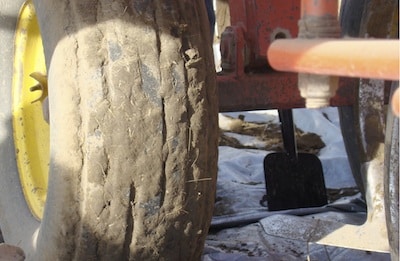Soil on seeding equipment is a key vector for the movement of clubroot spores from field to field. Cleaning dirt from equipment before leaving a clubroot-infested field is a good disease management practice. When soil is wet, it tends to stick that much more.
3 steps to equipment sanitation:

Step 1: Rough cleaning. This is the most important step. Use a hand scraper, wire brush or compressed air to remove loose and clinging soil and crop debris from openers, tires and wheels. Sweep, blow or scrape off the frame. This should remove at least 90% of the soil from the unit.
Step 2: Fine cleaning. Use a pressure washer at 2,000 to 3,000 psi on all areas where soil can accumulate. Turbo nozzles are generally more effective at removing soil than regular nozzles.
Step 3: Disinfection. Disinfect all openers, tires and wheels with a 1% bleach solution or surface disinfectant of equivalent strength. A 3-gallon backpack herbicide sprayer will work for this job. All areas should remain wet with the solution for 15 to 20 minutes.
For more details click to download: Clubroot Sanitation Guide
Keep in mind that by the time patches of clubroot infection are obvious in fields, clubroot spores may have been present for a while. As a result, this can lead to a greater buildup in concentration of clubroot spores in soils and wider distribution throughout fields and to neighbouring fields before steps are taken to limit the disease. Clubroot disease management plans will vary depending on the amount of disease and its severity, but growers in all regions — including Manitoba — should be on alert for the disease. Early detection and routine sanitation can really help keep disease levels manageable. Geography is not immunity.